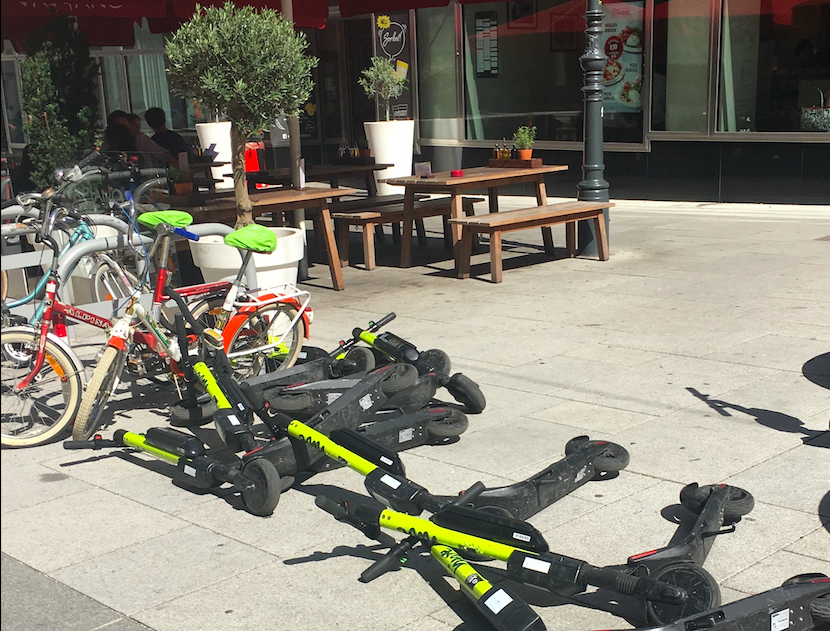
E-scooters seem less likely to run people off sidewalks than they did a year ago, with more riders operating them properly in bike lanes or roadways as opposed to zig-zagging their way around people on foot, USA Today reported last week. In addition, e-scooters are becoming less of a tripping hazard, as fewer of them tend to be found toppled in the path of pedestrians and are instead parked up neatly and orderly.
USA Today tech columnist Jefferson Graham made these observations in Los Angeles, a city which hosts more e-scooters than any other, numbering over 33,000 today. If this trend continues, perhaps a boost in their reputation could follow.
After ongoing backlash against e-scooters from the public, it’s certainly an encouraging development if people are using them more responsibly—though it should be noted the reporting in USA Today is somewhat anecdotal rather than being based on hard data. Indeed, Graham goes on to say it’s still the case that many riders continue to use e-scooters on sidewalks illegally.
Rider safety remains a concern, too. Product liability lawyer Jesse Halfon, writing in Citylab, cites a study of dockless e-scooter accidents conducted by the U.S. Centers for Disease Control and Prevention, which found that riders suffered an injury for every 5,000 miles ridden. Nearly half of those were head injuries, and a third were incurred by first-time riders, according to the study. So for sure, there is still much work to be done to add e-scooters safely to the transportation mix, as well as in overcoming public resistance.
Nevertheless, the observation of more responsible use comes not without some validity. This is almost certainly because transportation chiefs in cities where e-scooters are deployed have in many cases wrestled some control from the scooter operators by introducing regulations on their use and often imposing a cap on the number of scooters in service.
At the beginning of 2019, at least 44 e-scooter bills were introduced in 26 states, Halfon details in Citylab. This indicates that a maturation of the industry is afoot, and consistent with the anecdotal evidence from Los Angeles that Graham described in USA Today. It’s clear cities that have operated controlled pilot programs are seeing significant success in prompting more responsible usage.
San Francisco is a case in point. The city outright banned e-scooters several months after they were deployed. They appeared “overnight” uninvited on its streets and subsequently generated myriad complaints from the public, prompting the sudden time-out.
Following the ban, San Francisco permitted a reintroduction of e-scooters last October, but only as a year-long pilot program, with just two e-scooter operators selected by the city. The city also only allowed 1,250 scooters in total, and a number of responsibilities were placed on scooter operators to enhance their proper use.
Evidently, the pilot has been a success. Just last week, the San Francisco Municipal Transportation Agency (SFMTA) Board of Directors voted to make e-scooters a permanent addition to city streets in a 5-2 vote, Curbed San Francisco reported.
Back in June, the San Francisco Chronicle detailed some of the positive findings from the six-month point of the pilot, which no doubt contributed to the SFMTA’s decision to allow e-scooters to become a permanent fixture. The agency's director noted both reduced sidewalk riding and reduced illegal sidewalk parking. The nuisance factor to pedestrians was further mitigated as the two companies selected for the pilot had to ensure their scooters came with locks. This had the effect of ensuring scooters weren’t constantly toppled over, since they had to be locked to bike racks or posts when riders were finished with them.
After the pilot concludes in October, the number of scooters on San Francisco’s streets will increase, but SFMTA will retain control over the total number, as well as any decisions on who operates them, Curbed San Francisco reported. A spokeswoman for the city was pleased with the pilot, and she even lamented the fact the city hadn’t introduced a similar pilot program for app-based ride-hailing services, too.
The thing is, cities are actually quite keen to make e-scooters a successful part of the transportation infrastructure. To this point, the National League of Cities—an advocacy group for the nation’s cities and their leaders, with over 2,000 member cities—says in a recent report: “Micromobility promises smaller, more affordable and more environmentally sustainable modes of transportation.” The organization goes on to say these new modes of transport can be a way for cities to meet their sustainability goals as scooters often replace car trips.
Supporting this claim, Carolyn Said of the Chronicle writes that often, e-scooters are a means for people to get to mass transportation hubs, such as train stations, concluding: “Scooters induce transit trips at roughly four times the rate that they replace transit trips, indicating that they could complement transit by serving as a valuable last-mile connection.”
Scooters can also provide another social good when effectively regulated. For example, some cities have imposed regulations ensuring that units are deployed in low-income parts of the city, providing enhanced mobility options to members of the community who are typically less well served. Furthermore, in the case of Washington, D.C., operators are required to offer preferential rates for low-income residents.
There are still question marks hanging over whether e-scooter business models are poised to actually make money in the long run or not. Though it should be noted that just this week, e-scooter operator Bird was valued at $2.5 billion in a new funding round, indicating investor confidence remains robust. In any case, it certainly seems that both the scooter operators and city leaders should welcome a trend toward more responsible use. Indeed, it is in their mutual interests to work together toward that end.
Image credit: Phil Covington

Phil Covington holds an MBA in Sustainable Management from Presidio Graduate School. In the past, he spent 16 years in the freight transportation and logistics industry. Today, Phil's writing focuses on transportation, forestry, technology and matters of sustainability in business.














